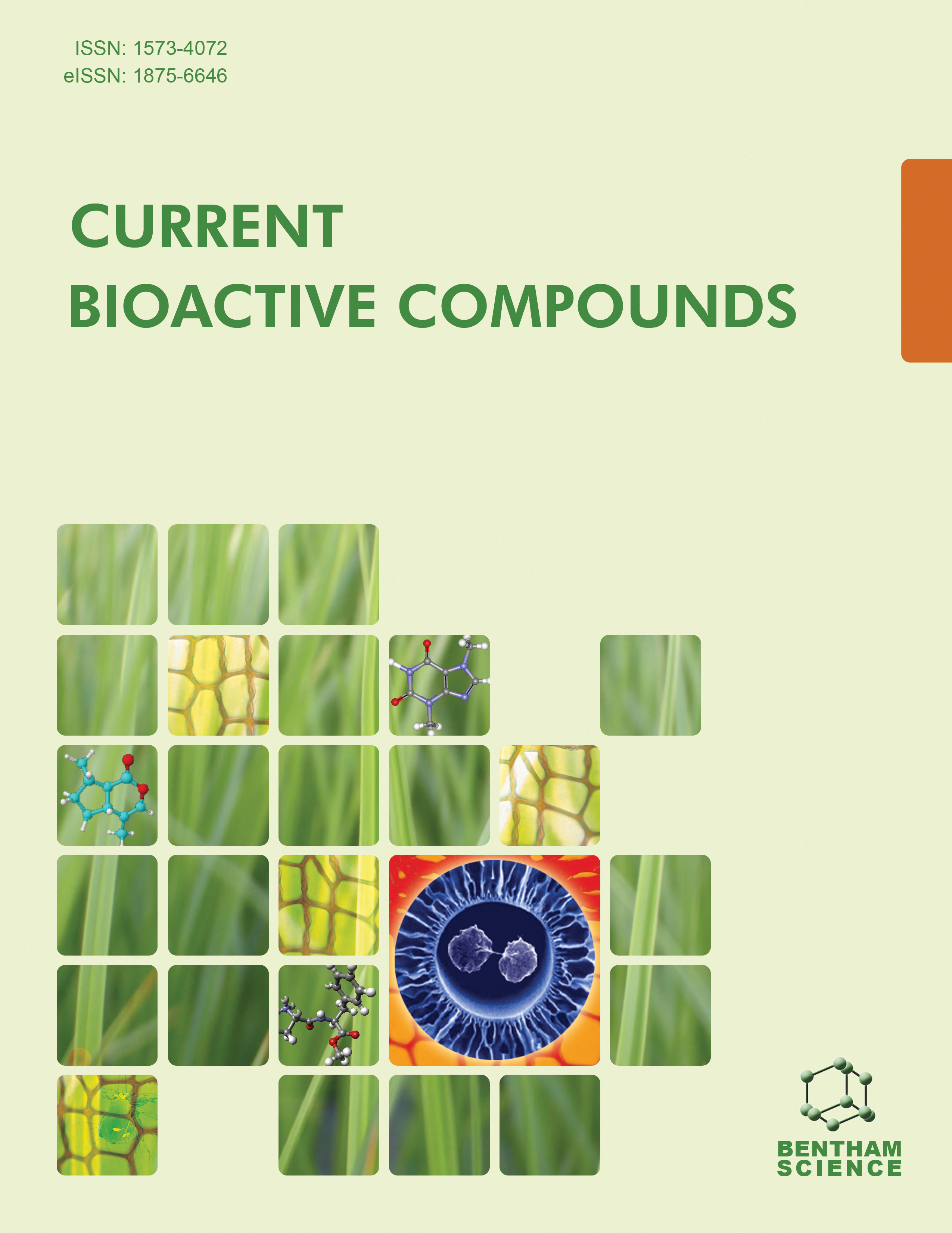- Home
- A-Z Publications
- Current Bioactive Compounds
- Previous Issues
- Volume 20, Issue 3, 2024
Current Bioactive Compounds - Volume 20, Issue 3, 2024
Volume 20, Issue 3, 2024
-
-
Prodigiosin: An In-depth Exploration of a Bioactive Compound from Serratia sp.
More LessAuthors: Sameer Ranjan Sahoo and Arun K. PradhanBackground: The rising interest in natural pigments as alternatives is a result of the expanding usage of synthetic colorants and the negative consequences that go along with them. Noble natural pigments with higher stability and productivity are becoming popular in the food industry, and their diverse biological characteristics make them valuable for pharmaceutical applications. Microbes, especially gram-negative and posi Read More
-
-
-
Synthesis, Characterization, and In vitro Evaluation of Short Cationic Peptides for Gene Delivery Vehicle Candidate
More LessBackground: Amongst gene delivery vehicles, peptide-based vectors have drawn the intensive attraction of experts globally due to their simplicity and many advantages due to ease in design, biocompatibility, and safety. Rationally designed peptides are capable of condensing DNA molecules efficiently and facilitating gene expression in the target cells. Objective: This study aims to design, synthesize and evaluate short cationic Read More
-
-
-
2D-QSAR Modeling, Docking, Synthesis and In-Vitro Evaluation of Novel Flavone Derivatives as Anticancer Agents
More LessAuthors: Remya R. Surajambika and Pavithra PalanikarasuBackground: Cancer is the second leading cause of death globally and is responsible for 10 million deaths in 2020 (2.26 million breast cancer deaths). Due to the problems like drug resistance, toxicities and economic burden, there is a need for the development of novel anticancer agents. Objectives: To design novel flavone derivatives by 2D QSAR studies and docking studies and to evaluate the compounds as potential anti Read More
-
-
-
Recent Developments and Future Prospects of Natural Antimicrobial Bioactive Metabolites Obtained from Endophytic Bacterial Isolate
More LessBackground: Adhatoda beddomei (Adosa), a kind of softwood, evergreen, perennial shrub, has been used as a source of endophyte bacteria. Adhatoda beddomei has a wide variety of chemicals, including anthocyanins, aminophylline, alkaloids, cardiac glycosides, isoprenaline, triterpenoids, resins, flavonoids, tannins, sterol, saponins, etc. The root, stem, and leaf parts of Adathoda beddomei are most often used Read More
-
-
-
Phytochemical and Pharmacological Potential of Ferula asafetida “Hing”
More LessAuthors: Sonia Singh, Arpit Shukla and Bhupesh C. SemwalAsafoetida, also known as Hing, is a resinous gum derived from the roots of Ferula species, specifically Ferula asafetida. From ancient times, it has been employed both in the kitchen as a seasoning and in the practice of traditional medicine. In terms of pharmacognosy, asafoetida is comprised of a number of active chemicals, the most notable of which are coumarins, volatile oils (17%), and ferulic acid (60%). Ferulic acid and co Read More
-
-
-
Studying the Optimization, Characterization, and Antioxidant Activities of Phenolic Extracts Extracted from Rhus chinensis Mill. Leaf using Microwave-assisted Extraction System with Glycerol as a Green Solvent
More LessBackground: The leaves of Rhus chinensis Mill., a common deciduous tree found in the mild temperate zone of Asia, have many medicinal effects, including antioxidant properties. Objectives and Methods: This study aims to optimize the conditions for extracting phenols from Rhus chinensis Mill. (RCM) using a microwave-assisted extraction system with glycerol (MAEG) via response surface methodology (RSM). It also aims to com Read More
-
-
-
Phytochemistry and Biological Assessment of Thuja articulata Trunk Barks: HPLC-PDA-ESI-MS Analysis, Bioevaluation, and Molecular Docking
More LessBackground: Thuja articulata is a Mediterranean forest species from the Cupressaceae family, it has been used in popular medicine to treat several diseases. Various studies have been carried out in vitro using diverse T. articulata extracts to understand its traditional use. Methods: In this study, the ethyl acetate extract of T. articulata trunk barks was chemically identified using HPLC-PDA-ESI-MS, then examined in vitro for its anti Read More
-
Volumes & issues
-
Volume 21 (2025)
-
Volume 20 (2024)
-
Volume 19 (2023)
-
Volume 18 (2022)
-
Volume 17 (2021)
-
Volume 16 (2020)
-
Volume 15 (2019)
-
Volume 14 (2018)
-
Volume 13 (2017)
-
Volume 12 (2016)
-
Volume 11 (2015)
-
Volume 10 (2014)
-
Volume 9 (2013)
-
Volume 8 (2012)
-
Volume 7 (2011)
-
Volume 6 (2010)
-
Volume 5 (2009)
-
Volume 4 (2008)
-
Volume 3 (2007)
-
Volume 2 (2006)
-
Volume 1 (2005)
Most Read This Month
Article
content/journals/cbc
Journal
10
5
false
en

Most Cited Most Cited RSS feed
-
-
Podophyllotoxin: Current Perspectives
Authors: Ying Qian Liu, Liu Yang and Xuan Tian
-
- More Less

